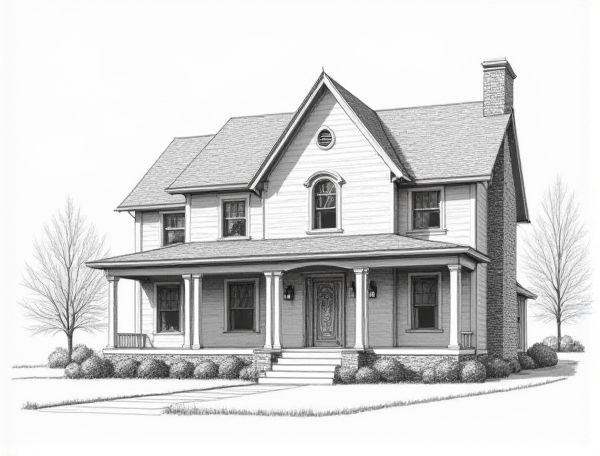
Photo illustration: Colonial Revival home design with dentil molding
Colonial Revival home design is characterized by its timeless elegance and distinctive architectural details such as dentil molding, which adds refined texture to cornices and enhances the overall classic aesthetic. You can explore how incorporating dentil molding elevates Colonial Revival interiors and exteriors by reading more in the article.
Introduction to Colonial Revival Home Design
Colonial Revival home design draws inspiration from early American colonial architecture, emphasizing symmetrical facades, multi-pane windows, and classic decorative elements like pilasters and pediments. This style often incorporates central entryways with sidelights and fanlights, alongside brick or wood clapboard exteriors that convey timeless elegance. Interior layouts typically feature formal living spaces, detailed woodwork, and traditional fireplaces, reflecting a balanced blend of historic charm and modern functionality.
Key Features of Colonial Revival Architecture
Colonial Revival architecture features symmetrical facades, gabled roofs, and multi-pane, double-hung windows often with shutters. Entryways typically showcase decorative pediments, columns or pilasters, and paneled doors with sidelights, emphasizing classical detailing and historical American colonial influences.
The Historical Significance of Dentil Molding
Dentil molding, a classical architectural element originating from ancient Greece and Rome, symbolizes precision and elegance in home design. This decorative trim features a series of small, evenly spaced blocks resembling teeth, often used to enhance cornices and cabinetry. Incorporating dentil molding into Your home design connects traditional craftsmanship with timeless aesthetic appeal, enriching Your living space with cultural and historical depth.
Incorporating Dentil Molding in Colonial Revival Homes
Incorporating dentil molding in Colonial Revival homes enhances architectural authenticity by adding intricate, evenly spaced tooth-like blocks along cornices and rooflines, emphasizing classical design elements. Your home's facade gains timeless elegance and detailed craftsmanship, elevating its historical charm and value.
Popular Materials for Dentil Molding
Dentil molding is commonly crafted from wood, polyurethane, and MDF, each offering durability and distinct aesthetic appeal; wood provides a classic, authentic texture while polyurethane resists moisture and decay, making it ideal for high-humidity areas. Your choice of material depends on the desired finish and budget, with MDF offering a cost-effective, paintable surface for intricate designs.
Interior Applications of Dentil Molding
Dentil molding enhances interior design by adding classical architectural detail to crown moldings, cabinetry, and fireplace mantels, creating a refined and timeless aesthetic. Its precise, evenly spaced rectangular blocks contribute depth and texture to walls and ceilings, enriching spaces with subtle elegance and historical charm.
Exterior Uses of Dentil Molding in Colonial Revival Homes
Dentil molding serves as a prominent architectural feature in Colonial Revival homes, often adorning cornices, pediments, and porch entablatures to enhance historical authenticity and visual rhythm. This precise series of small, rectangular blocks contributes to the classic symmetry and refined detailing that define Colonial Revival exterior aesthetics.
Tips for Restoring Dentil Molding in Historic Homes
Carefully remove layers of paint from dentil molding using gentle chemical strippers or low-heat tools to preserve intricate details and prevent damage. Fill cracks and missing pieces with epoxy wood filler matched to the original molding's wood type, then sand smoothly and repaint using breathable, historically appropriate paints to maintain authenticity.
Modern Takes on Colonial Revival with Dentil Detailing
Modern takes on Colonial Revival emphasize clean lines and minimalist aesthetics while preserving iconic dentil detailing around cornices and crown moldings. Incorporating dentil patterns in your home design enhances architectural authenticity and adds subtle texture that complements both traditional and contemporary elements. Your space benefits from this blend of historic charm and modern sensibility, creating a timeless, sophisticated atmosphere.
Choosing the Right Dentil Molding for Your Colonial-Style Home
Selecting the right dentil molding for your colonial-style home requires attention to authentic proportions and classical details, typically featuring evenly spaced, rectangular blocks that create a rhythmic pattern reflecting traditional Georgian and Federal architectural influences. Opt for high-quality wood or durable synthetic materials with crisp profiles and refined craftsmanship to enhance the home's historic elegance and complement its symmetrical facade.
 homedesy.com
homedesy.com